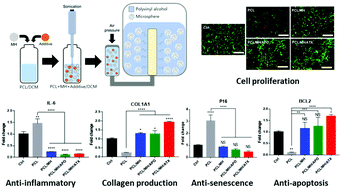Bioactive PCL microspheres with enhanced biocompatibility and collagen production for functional hyaluronic acid dermal fillers†
Abstract
Polymeric microspheres containing magnesium hydroxide (MH) and a bioactive agent (BA), such as apocynin (APO) and astaxanthin (ATX), have been prepared as functional dermal fillers with enhanced physicochemical and biological performance. In this study, polycaprolactone (PCL)-based microspheres were produced with a uniform size of about 30–40 μm by utilizing a membrane emulsification device. MH from the PCL/MH microspheres effectively neutralized acidic products from PCL degradation. For in vitro cell experiments, when acidic degradation products (6-hydroxycaproic acid, HCA) were treated with MH, the acidic pH was neutralized to induce wound healing and suppress inflammation. The microspheres comprised of BA had a sustained release of the BA, without an initial burst release. Remarkably, the ATX added into the microspheres was maintained for 16 weeks and displayed positive attributes, such as tissue regeneration and collagen production improvement, as noted by in vivo testing. Overall, these results suggest that the bioactive PCL microspheres containing ATX have excellent potential as a functional dermal filler for skin aesthetics and facial plastic surgery.

- This article is part of the themed collection: Biomaterials Science Recent HOT Articles


 Please wait while we load your content...
Please wait while we load your content...